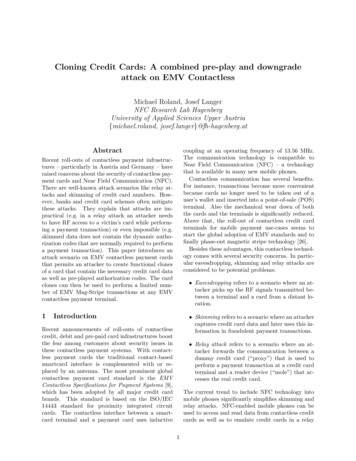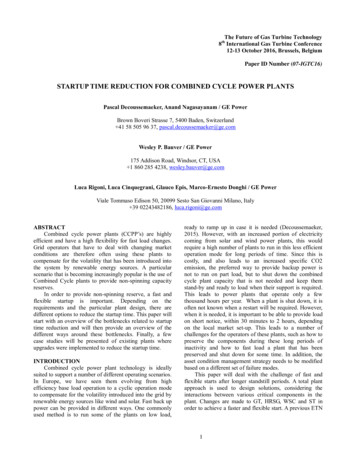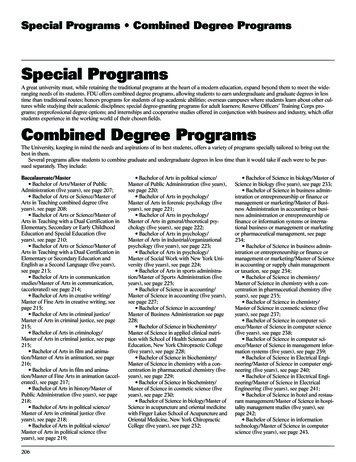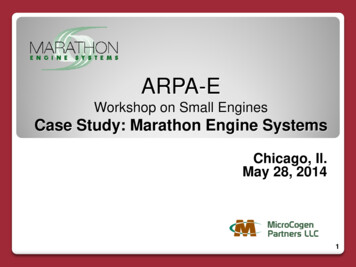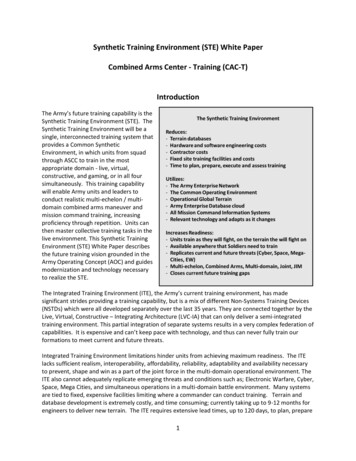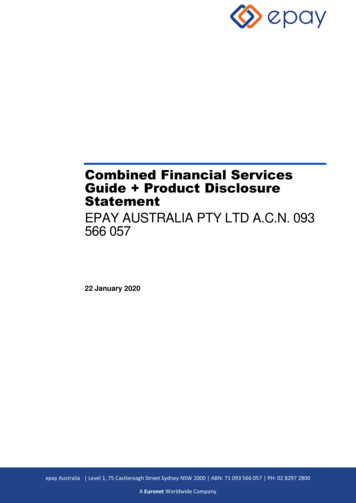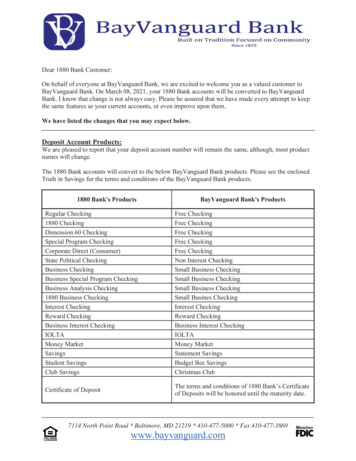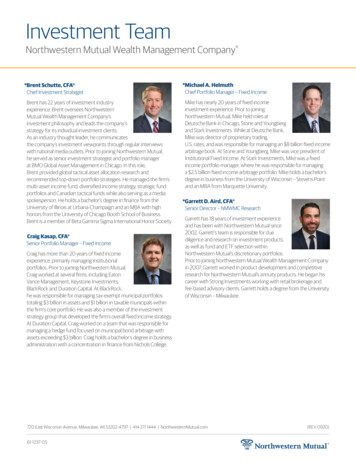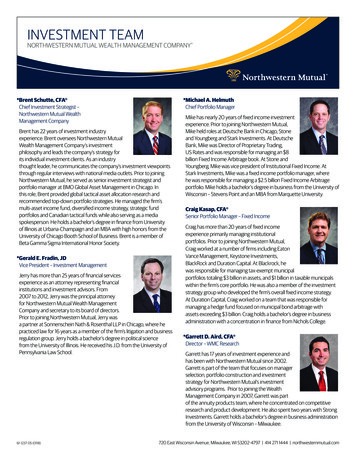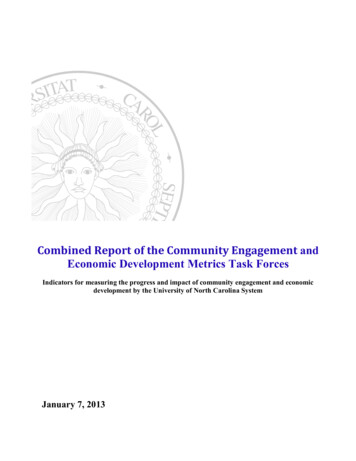
Transcription
Combined Report of the Community Engagement andEconomic Development Metrics Task ForcesIndicators for measuring the progress and impact of community engagement and economicdevelopment by the University of North Carolina SystemJanuary 7, 2013
UNC System Community Engagement and Economic Development MetricsPrepared by the Community Engagement and Economic Development Metrics Task ForcesFollowing the May 2012 University of North Carolina (UNC) System Engagement Summit at the University of NorthCarolina at Wilmington (UNCW), UNC President Tom Ross commissioned two multi-campus task forces to develop concisesets of indicators, or metrics, that all UNC campuses could use to assess “progress in community engagement and economicdevelopment” (Item 6.b., Summary of 2012 Institutional Goals and Priorities, Tom Ross). Community engagement andeconomic development are two critically important and closely interconnected strategies through which UNC students,faculty, staff, and alumni contribute to the promotion of vibrant, healthy, sustainable, and safe communities in NorthCarolina. Some key terms and definitions can be found in Appendix A.Collective IndicatorsThe development of system-wide indicators are the first step to building the capacity of General Administration, as well ascampuses individually, to understand the full scope and impact of UNC’s engagement in and with the state of North Carolina.Awareness of the types of and extent of activities serves as the first step towards being better able to [1] convey andstrengthen the UNC’s reputation as a collaborative, inclusive, responsible, and effective member of North Carolinacommunities, and [2] strengthen and support UNC’s capacity to be strategic, proactive, and responsive in developing,maintaining, and celebrating mutually beneficial community-university connections and partnerships.The metric areas were chosen because they align with the core educational and institutional priorities common across UNCcampuses, specifically commitments to excellence in teaching and learning, research and creative activities, and outreach andpublic service. Indeed, many campuses are now expected to identify, assess, and improve outcomes related tocommunity/public service as one of the five elements of institutional effectiveness in reaffirmation reports submitted to theSouthern Association of Colleges and Schools (SACS) (Standard 3.3.1.5). Systems established to centrally collect and reportthe data on an annual basis to General Administration will serve as the basis of campus responses to SACS standards.Beyond accreditation, the collection of the trial measures will encourage and allow individual campuses to: convene an institutional-level conversation with key constituents to embed into existing, and where necessary,establish new, systems for tracking and assessing the broad range of community-engaged activities, programs, andinitiatives across the institution; understand the full range and scope of community engagement purposes, activities, impact areas, and constituents; clarify goals for community engagement as a teaching pedagogy, as well as approach to research, creative activities,and public service, that serves to achieve key, institutional strategic goals; develop research agendas to assess the outcomes of various types of community and economic engagement activitieson students’ academic, personal, professional, and civic development and success; craft plans to support activities based on best practices and informed by campus-level data and key constituents; assess the outcomes and impacts of community engagement on university and community constituents; and strengthen the institution’s reputation as a proactive, as well as responsive, member of the greater North Carolinaand global communities.Much of the data identified in this collection effort will allow campuses to strengthen their own efforts to provide institutionlevel data about important and significant outcomes. For example, national research reported in A Crucible Moment: CollegeLearning & Democracy’s Future (National Task Force on Civic Learning and Democratic Engagement, 2012) and HowCollege Affects Students: A Third Decade of Research (Pascarella & Terenzini, 2005) demonstrates that service-learning(i.e., community-engaged courses) yields positive student outcomes related to academic, personal, professional, and civicdevelopment and success including: retention, degree completion, GPA, career clarification, connections to faculty, civicmindedness, participation in community service after graduation, self-confidence, social responsibility, social justice,personal efficacy, and the development of accepting attitudes towards cultural differences. (See Appendix B for references.)Trial PhaseAs indicators, the trial metrics are not expected to capture the full depth and scope of campus’s individual or collectiveengagement, nor will they replace other metrics traditionally collected to demonstrate the economic impact of campuses andthe System as a whole. Indicators are meant to provide understanding about scope and trends, not to fully capture anddescribe all related activities. The trial metrics proposed in this initiative focus primarily on inputs and activities as a first stepto greater understanding of UNC’s commitments to, relationships with, and impacts on citizens, communities, and businessesof North Carolina. While it is desirable to collect data on outputs and outcomes to assess the impact of the UNC institutions’efforts, the current state of data (and importantly, the capacity of campuses to collect and compile data in a common manneracross all UNC campuses) suggests that reporting outcomes is neither feasible nor desirable in this initial trial phase. Oncethe relative type and scope of engagement is known, further refinements to the metrics and mechanisms may be developed tosupport a more robust and efficient system for collecting, reporting, and using data. Metrics for academic year (AY) 20112012 will be due April 12, 2013 to Leslie Boney (lboney@northcarolina.edu) at General Administration.Feedback and Refinements1/7/20132
UNC System Community Engagement and Economic Development MetricsPrepared by the Community Engagement and Economic Development Metrics Task ForcesIt is important to recognize that the current capacity to assess progress in community engagement and economic developmentvaries across institutions as each has its own distinct mission, strategic goals and priorities, and resources that connectdifferentially to community engagement and economic development. To assist campuses to develop and implement strategicprocesses to collect data in the trial phase, the task forces will offer a series of videoconferences and meetings betweenDecember 2012 and March 2013. Campuses are asked to use the provided Excel template to report campus data for metricsfor Metrics 1, 3, and 4. Please submit a pdf or doc/docx file for Metric 5. (Metric 2 data will be collected by GeneralAdministration and does not require campus reporting.) An online Qualtrics form has also been developed to assist campusesto collect and report measures on community-university partnerships and projects (Metric Area 3), if they do not already havea system in place to collect such data. It is anticipated that campuses may elect to supplement these indicators with additionalinformation as they communicate their own stories of engagement. Additional or alternative metrics and measures may berecommended to the task force throughout the trial phase. All recommendations should address how the criteria for inclusionare met as outlined in the section below. In April 2013 the task forces will review the trial phase metrics and processes tosuggest modifications, adjustments, and/or abandonments of the recommended measures may be implemented to continue therefinement of the process.Criteria for Metrics[1] Provides useful indicators of community engagement and/or economic development across key university andcommunity constituents, including students, faculty, staff, alumni, residents and leaders.[2] Meaningfully demonstrates the pervasiveness and depth of UNC campus’s interconnectedness to, relationshipswith, and collective impact on the residents of North Carolina and beyond.[3] Provides useful information to inform the strategic directions of individual campuses, as well as the System as awhole.[4] Data that are commonly asked by accrediting and awards-granting agencies (e.g., SACS institutional effectivenessstandard 3.1.1.5; Carnegie Foundation’s elective classification for community engagement).[5] Recognized as indicators of community engagement or economic impacts resulting from university activities bynational associations involved in monitoring and measuring community engagement and economic development.[6] Collected annually to identify trends in community and economic engagement with adequate systems in place.Timeline and Process May 29, 2012 - Engagement Summit at UNCW June-September 2012 – Community engagement and economic development task forces develop recommendedtrial metrics based on extensive review of literature, best practices, and unique campus experiences of members. October 4 – 19, 2012 – Presentation and discussion of trial metrics by UNC campuses on videoconferencefollowed by request to campuses to provide further feedback. October 23 – November 13, 2012 – Trial metrics reviewed by President Tom Ross, UNC Faculty Assembly,and UNC Chancellors, then finalized by task forces. Late November, 2012 – Final trial metrics delivered to campuses to plan and begin data collection. December 6, 1-4pm 2012 – Videoconference to help campuses develop strategies to collect and use data. February 14, 1-3pm 2013 – Videoconference to answer questions as campuses get deeper into collection. April 12, 2013 – Trial metrics and feedback due from campuses to Leslie Boney at General Administration. May 2013 – June 2013 – Task forces to reconvene to review trial data and processes, and make modifications. July 1, 2013 – Trial phase ends. Campuses will receive request from General Administration to begin datacollection of metrics of AY2012-2013.Appointed Task Force MembersEmily Janke (Chair, Community Engagement Metrics, UNCG), Jerry McGuire (Chair, Economic Development Metrics,UNCG), Deborah Bailey (NCCU), Lynn Blanchard (UNC-CH), Angela Brenton (WCU), Leslie Boney (GA), ScottDaugherty (SBTDC), Terri Helmlinger Ratcliff (NCSU), Rocky Lane (ECSU), Zagros Madjd-Sadjadi (WSSU), NotisPagiavlas (WSSU), Mario Papparozzi (UNCP), Wayne Szafranski (NCAT), Ted Morris (ECU), Erin Schuettpelz (UNC-CH),Courtney Thornton (GA), Beth Velde (ECU), Kay Zimmerman (NCSU)Thank you to Individuals, Groups, and Campuses that Provided Additional Assistance and InputNational and international literatures, conversations, models, and colleagues have informed and shaped these metrics. Inputand feedback have been provided by a variety of people and groups, including the following: Barbara Holland (consultant),Zachary Smith (Economic development and Innovation Fellow, GA), Fiona Baxter (ECU), Alice Warren and colleagues(NCSU), Kristin Medlin UNCG), UNC Faculty Assembly, Institutional Research Directors, Economic TransformationCouncil, UNC Chancellors; Attendees on the October 4, 2012 videoconference, Andy Furco and colleagues from theUniversity of Minnesota Public Engagement Metrics Committee, and all contributing UNC campus representatives.1/7/20133
UNC System Community Engagement and Economic Development MetricsPrepared by the Community Engagement and Economic Development Metrics Task ForcesMETRIC AREA 1: Student Curricular Engagement – Through community-based, community-engaged, andentrepreneurship-focused learning experiences, students will develop and expand critical thinking skills, gain the ability toapply discipline-based theory to resolve challenges and problems faced by North Carolina residents across academicdisciplines, and be prepared to enter jobs in high growth and priority areas for North Carolina.MEASURE 1.1: Student Participation in Community-Based Academic Learning1.1a: Student Participation in Community-Engaged Academic Learning (if applicable)1.2: Formal Entrepreneurial Education Efforts (if applicable)1.3: Education Pipelines Focused on Health and Wellness1.4: Education Pipelines Focused on PreK-12 Education1.5: Job Placement, Earning Rates, and ResidencyWhat data campuses are to report for this metric* Total number and proportion of students participating in community-based learningcourses for academic credit [1.1] Total number and proportion of all students participating in community-engagedlearning courses for academic credit [1.1a] (if applicable) Total number of graduates with majors, minors, certificates or masters degrees in entrepreneurship programs [1.2](if applicable) Total number of courses offered within majors, minors, or certificates in entrepreneurship programs [1.2](OPTIONAL and if applicable)General Administration will collect data below. Campuses do not need to provide any of the data below. Total number of graduates who have been educated health and wellness professions [1.3] Total number of graduates who have been educated for preK-12 education professions [1.4] Total number of graduates who have been successfully certified and licensed for health & wellness professions[1.3] Total number of graduates who have been successfully certified and licensed for preK-12 education professions[1.4] Total number of graduates in jobs related to providing health and wellness services in NC [1.5] Total number of graduates in jobs related to providing preK-12 education in NC [1.5] Total number of students placed in jobs in NC within one year of graduation, includes all graduates at all levels[1.5] Earning rates of students placed in jobs in NC [1.5]*All metrics include undergraduate and graduate students, if applicableMEASURE 1.1. Student Participation in Community-Based Academic LearningDefinitions and criteria for inclusion as a community-based course Community is broadly defined to include any sector outside of higher education and professional disciplinaryassociations (the intention is to identify connections to entities external to higher education) Course must be offered for academic credit and tracked through the Registrar’s office (Note: The intention of thesetwo criteria is to be able to draw data from existing systems that are common across campuses – all campusessubmit student enrollment census survey each year.) Please provide data for AY2011-2012 (this follows FY2011-2012) Student participation will likely have duplicates in the sense that the same student may participate in severalcommunity-based courses each year. This metric will capture the number of opportunities given to students toengage through courses, rather than the discrete number (unduplicated count) of students who have had suchexperiences.Suggested processes to campuses for providing data: Review the full list of course markers used to identify course types (such as internships, field placements, practicas,teaching placements, service-learning, etc.) in the Registrar’s course schedule. Once your campus has identified the list of course type markers (e.g., INT, CLN, SVL, etc.), complete the provided Excelworksheet for this measure. This will request the following data:1. Semester (Categorize the summer session years following the protocol set for Institutional Researchers, asdescribed here: The summer session is assigned to the fiscal year in which the majority of the course wasdelivered. For example, if the majority of Summer Session 1 was delivered in FY2010-2011, it should bereported as AY2010-2011. If the majority of Summer Session 2 was delivered in FY2011-2012, it should bereported as AY2011-2012.)1/7/20134
UNC System Community Engagement and Economic Development MetricsPrepared by the Community Engagement and Economic Development Metrics Task Forces2.3.4.Course number (e.g., FSM101)Course type (e.g., SVL, INT, PRC, etc.) – please provide key of abbreviations at top of Excel File (e.g., INT internship; SVL service-learning; PRC practicum)Headcount for the course (use census enrollment data which captures enrollment on 10 th day of class)MEASURE 1.1a. Student Participation in Community-Engaged Academic Learning (if applicable*)*Some campuses, but not all, have a system for reviewing, approving, and/or tracking community-engaged learning throughreciprocal partnerships and for mutual benefit (such as service-learning) as a subset of community-based academic learning.This section is only applicable to campuses that have this system in place for designating and tracking such courses. SeeAppendix C for more discussion of why this (1.1a) is separate from (i.e., a subset of) Measure 1.1.Definitions and criteria for inclusion as a community-engaged course Community-engaged academic learning is a subset of community-based academic learningo Community-engaged is defined as involving “collaboration between institutions of higher education andtheir larger communities (local, regional/state, national, global) for the mutually beneficial exchange ofknowledge and resources in a context of partnership and reciprocity” (Carnegie Foundation). Communitybased is defined more broadly as taking place in the community or with a community partner. Community is broadly defined to include any sector outside of higher education and professional disciplinaryassociations (the intention is to identify connections to entities external to higher education) Course must be offered for academic credit and there must be a system for reliably tracking such courses year-toyear.NOTE: In the future, GA may modify its census enrollment data form to include a field that would allow for the collection ofMeasures 1.1 and 1.1a in its annual request for enrollment data. (Campus Institutional Research Offices typically overseethis.)MEASURE 1.2. Formal Entrepreneurial Education Efforts (if applicable*)*Some campuses, but not all, offer degree programs and/or certificates for individuals interested in entrepreneurship. Thismeasure is only applicable to campuses that offer formal entrepreneurial education in the form of majors, minors, certificateprograms, and/or masters programs.Definitions and criteria for inclusion Provide the total number of graduates in AY2011-2012 who received a minor, major, certificate or masters degree inentrepreneurship. It is not necessary to separate the count of graduate and undergraduate students; please report thetotal combined number. OPTIONAL*: Campuses may elect to report the number of courses offered for academic credit at the undergraduateor graduate level in which entrepreneurship content was embedded (AY2011-2012) and approved by the universitycurriculum committee as part of a major, minor, concentration, certificate, or master's program in Entrepreneurship.Learning objectives for the course must include specific entrepreneurship learning objectives to be counted. (Note:This optional metric area has been included upon request and is OPTIONAL, if the institution offers ENT courses.This metric allows campuses to report a spectrum of entrepreneurship activities beyond the ENT academicprograms, such as in cross-disciplinary courses. Responses will help to inform whether this metric should beincluded in the final metrics, and if so, the definitions, criteria for inclusion, and strategies to allow for commoncollection across UNC system campuses.)*Definitions and criteria for inclusion of ENT coursesCampuses that elect to report the number of courses should submit responses to the items below, in addition to thechosen data/measures:1. Definition of the measure and criteria for inclusion2. Description of how the data is tracked to ensure accuracy and consistency of data (also, if duplicate counts)3. Description of how the data is used
Total number of graduates with majors, minors, certificates or masters degrees in entrepreneurship programs [1.2] (if applicable) Total number of courses offered within majors, minors, or certificates in entrepreneurship programs [1.2] (
